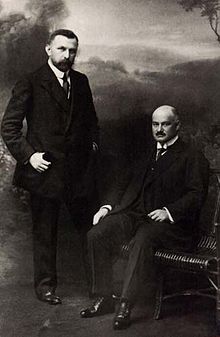Fritz Hoffmann-La Roche
Fritz Hoffmann-La Roche, later Hoffmann-von der Mühll (born October 24, 1868 in Basel ; † April 18, 1920 ibid), is the founder of a Swiss pharmaceutical company from which today's global group Roche has developed.
He was the third child of Friedrich Hoffmann and Anna Elisabeth Merian. Both parents came from well-known Basel families ( Daig ). A grandfather of the mother (Johann Jakob Merian) was a founder of the trading company Frères Merian . The father's family had been successful in the silk ribbon industry since 1669 and later in the development of tar dyes .
Fritz Hoffmann successfully completed a banking apprenticeship in Yverdon in 1886 and then completed an additional apprenticeship in the Basel drugstore Bohny, Hollinger & Co. He then worked for a London chemical trading company. In 1892 he found employment in a grocery store in Hamburg , where he experienced the cholera epidemic of 1892 .
After the end of the quarantine he was able to return to Basel to become a business partner of the drugstore Bohny, Hollinger & Co. in 1893. There he headed the attached chemistry laboratory, which produced floor wax and essential oils . Soon, however, there was a falling out with the owner of the company and in order to forestall a dismissal, he obtained 90,000 Swiss francs from his father , bought up the laboratory and founded the Hoffmann, Traub & Co company in 1894 with Max Carl Traub (1855–1919) . The new company first developed a wound product called Airol , but it only achieved moderate sales success.
In 1895 Fritz Hoffmann married Adèle La Roche. When Max Carl Traub left the company in 1896, it was renamed F. Hoffmann-La Roche & Co. on October 1st . In the same year Hoffmann hired the chemist Emil Christoph Barell . Barell was the leading figure at Roche until the 1950s.
In 1898 a cough syrup called Sirolin was created and intensively advertised. Despite its dubious efficacy, this drug brought the commercial breakthrough and Fritz Hoffmann-La Roche became very wealthy. Up until the First World War , Hoffmann established branches in Germany (1897), Paris (1903), New York (1905), Vienna (1907), London (1908), St. Petersburg (1910) and Yokohama (1912).
The company ran into great difficulties as a result of the World War and the October Revolution in Russia . In 1918 Hoffmann also fell ill with severe kidney disease. The company could no longer be saved without outside capital and was converted into a stock corporation.
Hoffmann's influence on the company's business operations waned. In April 1919, his health continued to deteriorate. In the summer of the same year he divorced his wife Adèle and married his long-time lover Elisabeth von der Mühll, with whom he retired to Ticino . In March 1920 he returned to Basel terminally ill and died there on April 18th. He couldn't see how his company became one of the most important drug manufacturers.
Fritz Hoffmann-La Roche was one of the first to see the importance of standardized branded drugs in medicine.
His son Emanuel Hoffmann was very interested in modern art. His collection formed the basis for the Emanuel Hoffmann Foundation founded by his wife Maja Sacher .
He found his final resting place in the Wolfgottesacker cemetery in Basel. The grave sculpture was created by Johann Michael Bossard .
literature
- Thomas Schibler: Hoffmann-La Roche, Fritz. In: Historical Lexicon of Switzerland .
- Berend Strahlmann: Hoffmann, Fritz. In: New German Biography (NDB). Volume 9, Duncker & Humblot, Berlin 1972, ISBN 3-428-00190-7 , p. 395 f. ( Digitized version ).
- Peyer, Hans Conrad: Roche - history of a company 1896-1996 , Basel 1996. ISBN 3-907770-68-4 .
- Alex Capus : Patriarchs: Ten Portraits , Albrecht Knaus-Verlag, Munich 2006. ISBN 3-813502-73-2 .
- Jesko Dahlmann: Innovative entrepreneurship in the sense of Schumpeter: theory and economic history. Metropolis Verlag, Marburg 2017, ISBN 978-3-7316-1269-8 , p. 453 ff.
Web links
| personal data | |
|---|---|
| SURNAME | Hoffmann-La Roche, Fritz |
| BRIEF DESCRIPTION | Founder of Hoffmann-La Roche |
| DATE OF BIRTH | October 24, 1868 |
| PLACE OF BIRTH | Basel |
| DATE OF DEATH | April 18, 1920 |
| Place of death | Basel |

